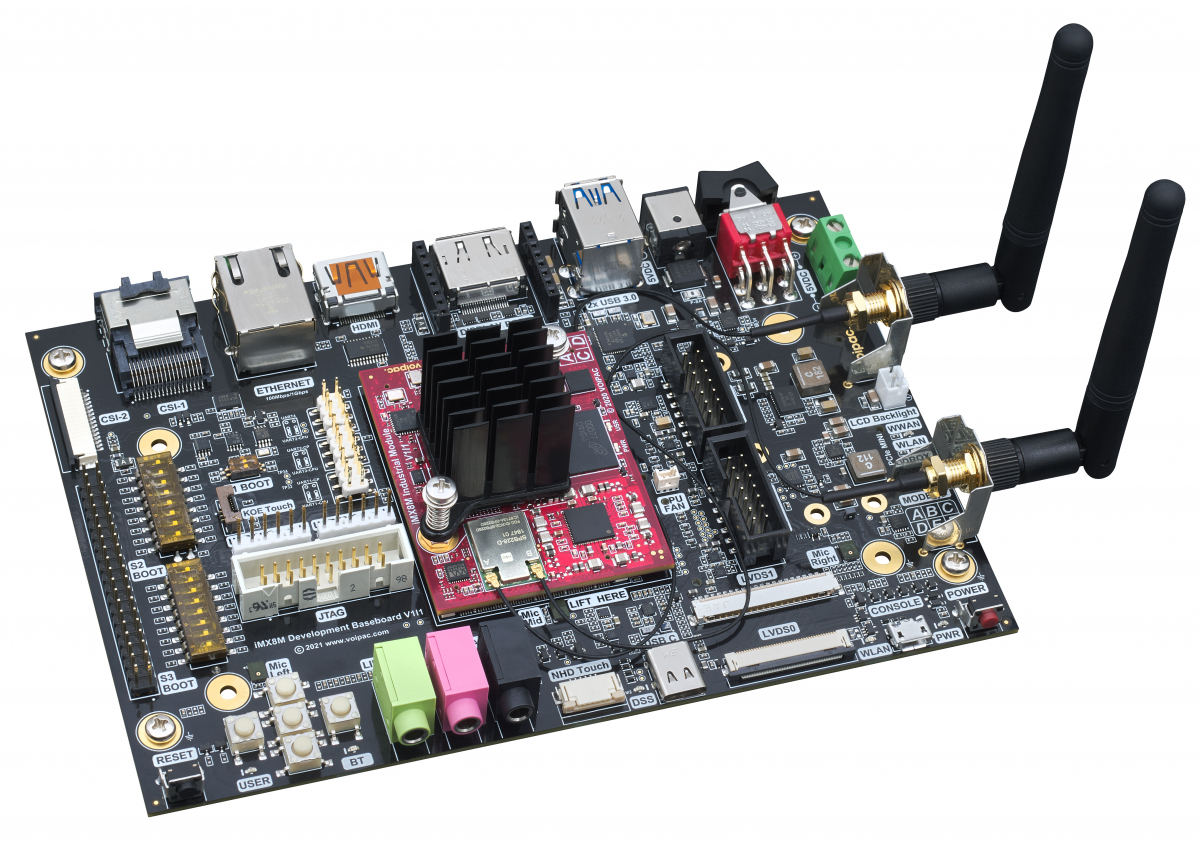Board description
This embedded system with i.MX 8M ARM® Cortex®-A53 core and real-time Cortex-M4 co-processor was designed as a development platform for the iMX8M Industrial Module, which includes all of the layout and technologically intensive parts, thus when used as part of the final device, significantly reduces its time-to-market.
The EMC certified kit features all of the essential high-speed interfaces such as eMMC NAND Flash, LP-DDR4 RAM, PCI Express, USB 3.0 together with several HD video options, and further supports numerous communication peripherals like WiFi, Bluetooth, Ethernet, or Audio - all of them soldered right on the iMX8M Industrial Computer on Module (COM).
The peripheral-rich iMX8M Development Baseboard was created to present the functionality, connectivity and performance of the iMX8M Industrial COM. It does not only provide flexible development environment, but offers numerous design features or connectivity options by its own.
URL: iMX8M Industrial Development Kit | VOIPAC TECHNOLOGIES s.r.o.
Wiki: iMX8M Industrial Development Kit | Wiki page
GitHub: iMX8M Industrial Development Kit | GitHub page
Test results
The Yocto Project releases in the table below have been tested by the Mender community. Please update it if you have tested this integration on other Yocto Project releases:
TODO: Update table below with Yocto Project versions tested & result. Sample data:
| Yocto Project | Build | Runtime |
|---|---|---|
| dunfell (3.1) |
|
1. Build issue due to systemd-network…workaround steps…
2. Board does not boot, freezes after U-Boot prompt with the following message…
Build Means that the Yocto Project build using this Mender integration completes without errors and outputs images.
Runtime Means that Mender has been verified to work on the board. For U-Boot-based boards, the integration checklist has been verified.
Getting started
Prerequisites
- A supported Linux distribution and dependencies installed on your workstation/laptop as described in the Yocto Mega Manual
- NOTE. Instructions depend on which Yocto version you intend to use.
- Google repo tool installed and in your
PATH.
Configuring the build
Setup Yocto environment
Set the Yocto Project branch you are building for:
# set to your branch, make sure it is supported (see table above)
export BRANCH="dunfell"
Create a directory for your mender-<TARGET> setup to live in and clone the
meta information.
mkdir mender-<TARGET> && cd mender-<TARGET>
Initialize repo manifest:
repo init -u https://github.com/mendersoftware/meta-mender-community \
-m meta-mender-<TARGET>/scripts/manifest-<TARGET>.xml \
-b ${BRANCH}
Fetch layers in manifest:
repo sync
Setup build environment
Initialize the build environment:
source setup-environment <TARGET>
NOTE! You need to accept the Freescale EULA at ‘…/sources/meta-freescale/EULA’. Please read it and in case you accept it, add:
ACCEPT_FSL_EULA = "1"
in your local.conf.
Configure Mender server URL (optional)
This section is not required for a successful build but images that are generated by default are only suitable for usage with the Mender client in Standalone deployments, due to lack of server configuration.
You can edit the conf/local.conf file to provide your Mender server configuration, ensuring the generated images and Mender Artifacts are connecting to the Mender server that you are using. There should already be a commented section in the generated conf/local.conf file and you can simply uncomment the relevant configuration options and assign appropriate values to them.
Build for Hosted Mender:
# To get your tenant token:
# - log in to https://hosted.mender.io
# - click your email at the top right and then "My organization"
# - press the "COPY TO CLIPBOARD"
# - assign content of clipboard to MENDER_TENANT_TOKEN
#
MENDER_SERVER_URL = "https://hosted.mender.io"
MENDER_TENANT_TOKEN = "<copy token here>"
Building the image
You can now proceed with building an image:
MACHINE=imx8mq-voipac bitbake core-image-base
Replace core-image-base with your desired image target.
Using the build output
After a successful build, the images and build artifacts are placed in tmp/deploy/images/imq8mq-voipac/.
The disk image (with .sdimg.bz2 suffix) is used to provision the device storage for devices without Mender running already. Please proceed to the official documentation on provisioning a new device for steps to do this.
On the other hand, if you already have Mender running on your device and want to deploy a rootfs update using this build, you should use the Mender Artifact files, which have .mender suffix. You can either deploy this Artifact in managed mode with the Mender server (upload it under Releases in the server UI) or by using the Mender client standalone mode.
Flashing instructions
Please follow official wiki page: iMX8M Industrial Flashing Procedure - Voipac Wiki for image flashing.
References
- The official Mender documentation explains how Mender works. This is simply a board-specific complement to the official documentation.
